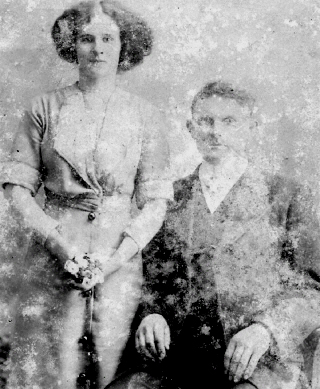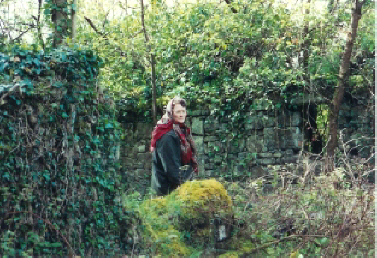|
Biographies of Our Forefathers
Bernard 'Benny' Tinneny
 Bernard
was the first son and second child of Francis Tinneny and
Catherine McConnell. He was born at Goladuff in 1882.
He was baptized at Saint Mary's Church, Newtownbutler on June 5,
1882. His baptismal sponsors were Philip Doneha and
Catherine Tinneny. Benny probably never attended school
since on the 1901 census he is listed as not being able to read.
This was not uncommon in those days, especially for the sons of
farmers. Bernard
was the first son and second child of Francis Tinneny and
Catherine McConnell. He was born at Goladuff in 1882.
He was baptized at Saint Mary's Church, Newtownbutler on June 5,
1882. His baptismal sponsors were Philip Doneha and
Catherine Tinneny. Benny probably never attended school
since on the 1901 census he is listed as not being able to read.
This was not uncommon in those days, especially for the sons of
farmers.
Photo: Believed to be
Benny and the unidentified woman he had planned to marry.
Mary McGarvey, Benny's cousin, remembered Benny as being very
quiet. She told a story of the time when as a young girl
she was walking down the Quivvy Road on her way to school in
Belturbet when she saw Benny walking ahead of her. He was
on his way to the cockfights in Belturbet, attendance at which
was one of his favorite pastimes. Both Benny and his
brother Pat raised and trained fighting cocks. Mary found
a one-pound note on the road. She told her mother, Alice
Tinneny McGuinness, about finding the note. Her mother
asked her if she saw anyone else on the road ahead of her.
Mary said yes, that Benny had been walking ahead of her.
Mary returned the note to Benny who gave her a half crown coin
as a reward.
Benny was a big man, about 6 foot 1"inch tall. He was
tanned, wiry and wore a cowboy hat to protect him from the sun.
Unlike many of the other Tinnenys on Goladuff he didn't play a
musical instrument. However, he did enjoy singing.
Benny’s niece Maisie Tinneny Brady remembered him as liking
children more than some of his brothers. She remembered
him coming to their house at Quivvy when she and her brother and
sister were growing up. She said that he would always have
sweets for the children. The candies were unwrapped in his
pocket and the kids would go into his pockets and take them out.
Maisie recalled how the candy would always have tobacco and dust
clinging to it.
Benny owned a stone house and farm at Quivvy. It was
located between Alice's land and Hugh's land and was not far
from the home of Hubert and Susanna Tinneny in 2001. In
addition to the pastures where he grazed cattle and the
cultivated areas on which he grew flax for linen and hay,
Benny's land had many thickly wooded acres that ran down to the
Quivvy Lough.
Benny was known throughout the area for making and selling
poteen, which is home made whiskey. He made the whiskey in
stills that were located throughout the wooded areas on his
land. Although there was the house on Benny's land at
Quivvy, Benny did not live in it. He lived with his
brother Francis in what was their father's homeplace on Goladuff.
Bridie and Francie
Tummin of Goladuff who were the children of Benny's neighbors,
the Tummins', told of the times when they were young when Benny
visited their father's home every night. As he entered the
house he would always say "God bless all here." One day he
brought little Bridie a lovely yellow and white puppy. He
said he would leave it there until he had a chance to build it a
wee little house to live in near his house. Every night he
came to visit them he would say that he didn't have the house
built yet but I will soon and will take it away soon. He
never did get the house built and never planned to -- that was
his way of giving Bridie the little puppy. They also
remembered that Benny liked to sit and talk with and tell
stories to the children. They said “He was a real
gentleman." Francie and Bridie
 Tummin
remembered how heart broken they were when as children Benny was
sent by the doctor to the hospital in Enniskillen where he died. Tummin
remembered how heart broken they were when as children Benny was
sent by the doctor to the hospital in Enniskillen where he died.
Benny died of heart problems in the Enniskillen hospital about
1950 or 1951. His wake which was held at the home of his
brother Hugh Tinneny at Quivvy, Belturbet lasted for 2 days.
He was buried in Drummully Cemetery.
Photo: Susanna Tinneny
in the ruins of Benny Tinneny’s house in Quivvy.
Photo by R. J. Tinneny
In 1998, Benny's land at Quivvy belonged to his nephew Hubert
who grazed cattle on it in the summer. A visit to his land
in 1992 revealed the remains of old stone houses on the
property, some of which pre-date the time of the famine in the
mid 1800s. There were no livable houses on the property in
2001. The partial remains of Benny's house could still be
seen but many of the stones had been removed from it to be used
in other construction projects.
Note: no knows
descendants.

|